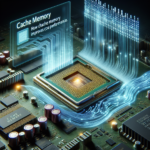Explaining the Process of CPU Microcode Updates

Explaining the Process of CPU Microcode Updates
In the realm of computing, the Central Processing Unit (CPU) is often referred to as the brain of the computer. It executes instructions and processes data, making it a critical component of any computing system. However, like any complex system, CPUs are not immune to bugs and vulnerabilities. One of the ways to address these issues is through CPU microcode updates. This article delves into the intricacies of CPU microcode updates, explaining what they are, why they are necessary, and how they are implemented.
What is CPU Microcode?
Before diving into the update process, it is essential to understand what CPU microcode is. Microcode is a layer of low-level code that translates high-level machine instructions into the actual electrical signals that control the CPU’s hardware. Essentially, it acts as an intermediary between the software and the hardware, ensuring that the CPU executes instructions correctly.
Functions of Microcode
Microcode serves several critical functions:
- Instruction Decoding: It helps in decoding complex instructions into simpler operations that the CPU can execute.
- Hardware Control: It manages the various hardware components within the CPU, such as registers, ALUs (Arithmetic Logic Units), and caches.
- Error Handling: It can include routines for error detection and correction, enhancing the reliability of the CPU.
- Performance Optimization: It can optimize the execution of frequently used instructions, improving overall performance.
Why Are CPU Microcode Updates Necessary?
Microcode updates are essential for several reasons:
Bug Fixes
Despite rigorous testing, CPUs can have bugs that only become apparent after widespread use. Microcode updates can fix these bugs without requiring changes to the hardware.
Security Vulnerabilities
Security vulnerabilities, such as the infamous Spectre and Meltdown, can be mitigated through microcode updates. These updates can implement new security measures to protect against emerging threats.
Performance Enhancements
Microcode updates can also include performance improvements, optimizing the execution of specific instructions or enhancing the efficiency of hardware components.
Compatibility
As new software and operating systems are developed, microcode updates can ensure that older CPUs remain compatible with new technologies.
The Process of CPU Microcode Updates
The process of updating CPU microcode involves several steps, from development to deployment. Here is a detailed look at each stage:
1. Identification of Issues
The first step in the microcode update process is identifying the issues that need to be addressed. This can involve:
- Bug Reports: Users and developers may report bugs that require a microcode update.
- Security Audits: Security researchers may discover vulnerabilities that need to be patched.
- Performance Analysis: Performance bottlenecks may be identified through benchmarking and profiling.
2. Development of Microcode
Once the issues are identified, the next step is developing the microcode update. This involves:
- Design: Engineers design the new microcode routines to address the identified issues.
- Implementation: The new microcode is implemented and tested in a controlled environment.
- Validation: The updated microcode undergoes rigorous testing to ensure it resolves the issues without introducing new problems.
3. Distribution of Microcode Updates
After the microcode update is developed and validated, it needs to be distributed to end-users. This can be done through:
- Firmware Updates: Microcode updates are often included in firmware updates provided by the CPU manufacturer.
- Operating System Updates: Operating system vendors may include microcode updates in their regular updates.
- BIOS/UEFI Updates: Motherboard manufacturers may include microcode updates in BIOS/UEFI updates.
4. Application of Microcode Updates
Once the microcode update is distributed, it needs to be applied to the CPU. This can be done in several ways:
- During Boot: The BIOS/UEFI can apply the microcode update during the boot process.
- At Runtime: The operating system can apply the microcode update at runtime, although this is less common.
Challenges and Considerations
While microcode updates are essential, they come with their own set of challenges and considerations:
Compatibility Issues
Microcode updates need to be compatible with a wide range of hardware and software configurations. Ensuring compatibility can be challenging, especially for older systems.
Performance Impact
While microcode updates can improve performance, they can also introduce performance overhead. Balancing security and performance is a critical consideration.
Security Risks
Microcode updates themselves can be a vector for attacks if not properly secured. Ensuring the integrity and authenticity of microcode updates is crucial.
End-User Awareness
Many end-users are unaware of the importance of microcode updates. Educating users about the need for regular updates is essential for maintaining system security and performance.
FAQ
What is CPU microcode?
CPU microcode is a layer of low-level code that translates high-level machine instructions into the actual electrical signals that control the CPU’s hardware. It acts as an intermediary between the software and the hardware, ensuring that the CPU executes instructions correctly.
Why are CPU microcode updates necessary?
Microcode updates are necessary to fix bugs, address security vulnerabilities, improve performance, and ensure compatibility with new software and technologies.
How are CPU microcode updates distributed?
Microcode updates can be distributed through firmware updates, operating system updates, and BIOS/UEFI updates provided by CPU manufacturers, operating system vendors, and motherboard manufacturers, respectively.
Can microcode updates impact performance?
Yes, microcode updates can impact performance. While they can improve performance by optimizing instruction execution, they can also introduce performance overhead, especially when addressing security vulnerabilities.
How can I ensure my CPU has the latest microcode updates?
To ensure your CPU has the latest microcode updates, regularly update your operating system, firmware, and BIOS/UEFI. Check for updates from your CPU manufacturer, operating system vendor, and motherboard manufacturer.
Conclusion
CPU microcode updates play a crucial role in maintaining the reliability, security, and performance of modern computing systems. By understanding the process of microcode updates, from identification and development to distribution and application, users and administrators can better appreciate the importance of keeping their systems up-to-date. While challenges exist, the benefits of microcode updates far outweigh the potential drawbacks, making them an essential aspect of modern computing.




